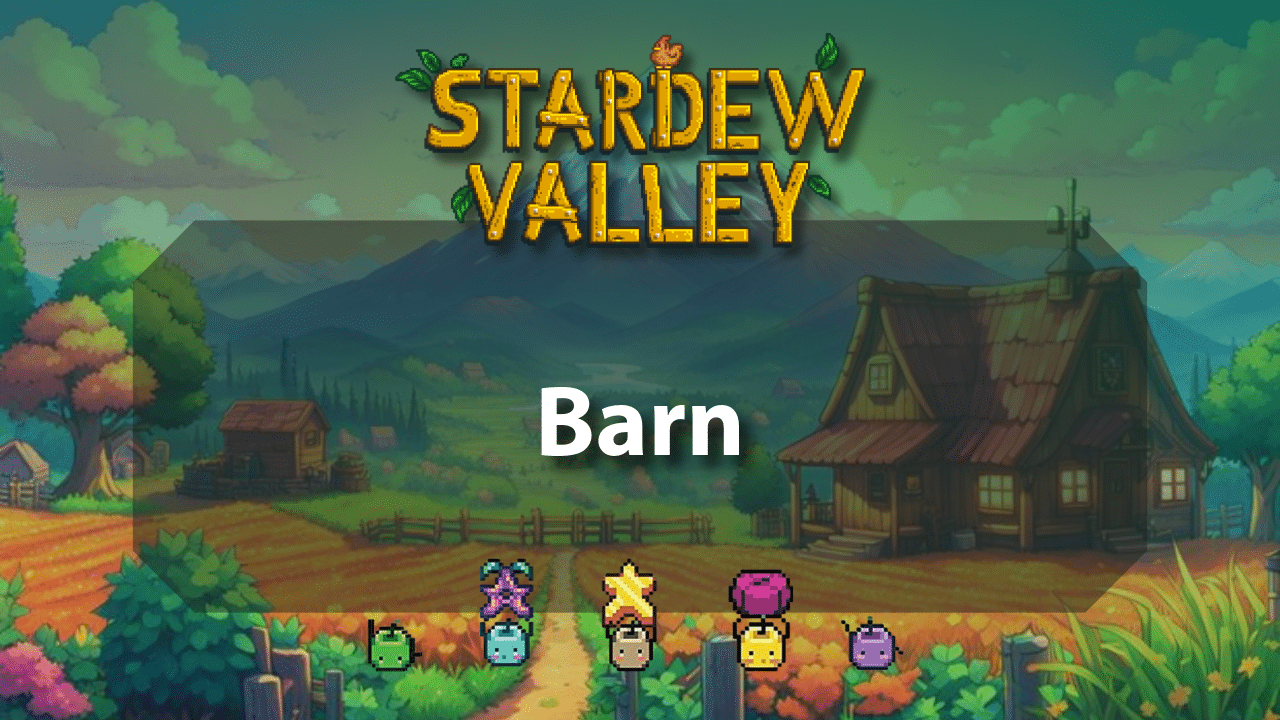
Obtaining a Barn
In Stardew Valley, the barn is a crucial building for raising livestock and expanding your farm’s production. Owning a Stardew Valley Barn allows you to house animals like cows, goats, sheep, and pigs, each providing valuable resources such as milk, wool, and truffles. To get started, you must purchase a barn from Robin at the Carpenter’s Shop, which is located north of Pelican Town.
The shop is open from 9:00 AM to 5:00 PM most days, except Tuesdays when it’s closed unless it’s raining. Constructing a basic barn requires 6,000 gold, 350 wood, and 150 stone, and it takes three days to complete. During construction, Robin will be busy building and will be unavailable for dialogue or gifting. Once finished, the barn can hold up to four animals, allowing you to start collecting animal products that can be used for cooking, crafting, or selling for profit.
Upgrading your Stardew Valley Barn increases its capacity and unlocks new features. The Big Barn, which costs 12,000 gold, 450 wood, and 200 stone, expands the space to accommodate eight animals and introduces the ability to house goats. The Deluxe Barn, the final upgrade, costs 25,000 gold, 550 wood, and 300 stone, and it allows up to 12 animals while unlocking sheep and pigs. Pigs are especially valuable as they can find truffles outside, which can be sold for a high price or turned into truffle oil for even greater profit. Upgrading also adds an automatic feeding system, making animal care more convenient.
Keeping your barn animals happy is essential for maximizing their production. Animals require daily interaction to increase friendship levels, which results in higher-quality products. Feeding them is also crucial, and while they can graze on grass outside during warm seasons, you’ll need to provide hay in the winter. Building a silo and cutting grass with a scythe stores hay for later use, ensuring your animals stay well-fed year-round. Additionally, keeping the barn clean and ensuring all animals have space to move will help maintain their happiness.
Investing in a Stardew Valley Barn is an important step for any farmer looking to expand their income and farm operations. Whether you focus on dairy products, wool, or truffle farming, a well-maintained barn and happy animals will provide a steady and profitable resource stream.
Barn Placement
Barn InteriorWhen designing your farm layout in Stardew Valley, proper barn placement is essential for efficient farm management and maximizing animal happiness. Each barn, regardless of its tier, occupies a 7×4 tile space, so it’s important to plan ahead and ensure there is enough cleared land before construction. Before purchasing a barn from Robin at the Carpenter’s Shop, remove any obstacles such as rocks, trees, grass, and wood to create a suitable area for building. Since the barn is a key structure for raising livestock, its location can significantly impact the ease of daily chores. Placing the barn in a central location or near commonly used farm buildings, such as the silo, can help streamline feeding and animal care.
Big Barn InteriorGrazing space is another factor to consider when setting up a barn. Animals that are allowed to roam outside on sunny days will have improved mood, leading to better-quality products such as higher-quality milk, wool, and truffles. Ensuring there is enough open space around the barn allows cows, goats, sheep, and pigs to move freely, increasing their overall happiness. Fences can be useful for keeping animals within a designated grazing area, preventing them from wandering too far and making it easier to gather them at the end of the day. Additionally, placing a gate in the fence allows easy access for farmers to move in and out without hassle.
Deluxe Barn InteriorThe placement of silos near the barn is particularly beneficial, as it makes hay management more convenient. During colder months or rainy days when animals cannot graze outside, having a steady supply of hay is necessary to keep them well-fed. The automatic feeding system in a Deluxe Barn simplifies this process by dispensing hay directly into the troughs, but in earlier barn upgrades, manually placing hay is required. Having the barn close to a silo reduces the time spent collecting and distributing hay, making daily farm tasks more efficient.
Considering the long-term growth of your farm is also important when placing a barn. If you plan to expand and upgrade to a Big Barn or Deluxe Barn, ensure there is enough space nearby for future expansions. Having multiple barns in one area can help organize different types of animals while maintaining a structured and visually appealing farm layout. Some farmers prefer separating barns from coops, while others integrate them into the same section for convenience.
Proper barn placement improves workflow and ensures optimal conditions for raising animals efficiently. With careful planning, you can create a layout that makes tending to livestock easier while maximizing happiness and product quality.
Barn Tiers and Upgrades
Barns in Stardew Valley are essential for raising livestock, and upgrading them allows farmers to increase their animal capacity while unlocking valuable new features. Each upgrade is purchased from Robin at the Carpenter’s Shop and takes two days to complete. During construction, the barn remains fully functional, allowing farmers to continue feeding and caring for their animals without interruption. Proper barn upgrades are crucial for expanding a farm’s productivity, as higher-tier barns accommodate more animals and provide useful features that streamline daily farm operations.
The first upgrade, the Big Barn, costs 12,000 gold, 450 wood, and 200 stone. This upgrade increases the barn’s capacity from four to eight animals and introduces the ability to house goats, which produce goat milk that can be processed into goat cheese for higher profits. Additionally, the Big Barn allows barn animals, including cows and goats, to become pregnant, enabling farmers to expand their livestock without purchasing new animals from Marnie’s Ranch. If pregnancy is enabled, there is a chance that an animal will give birth overnight, provided there is an available space in the barn. This feature makes it easier to grow a herd without the upfront cost of buying additional animals.
The final upgrade, the Deluxe Barn, costs 25,000 gold, 550 wood, and 300 stone. This upgrade further increases the barn’s capacity to twelve animals and unlocks the ability to house sheep and pigs. Sheep produce wool, which can be turned into cloth using a loom, while pigs can find truffles when allowed to roam outside. Truffles are one of the most valuable animal products in the game, and they can be processed into truffle oil for even higher profits.
One of the most convenient additions of the Deluxe Barn is the automatic feeding system, which distributes hay directly to the feeding bench. This feature eliminates the need to manually place hay in the troughs each day, ensuring that animals are consistently fed, especially during winter when grazing outside is not an option.
The total cost to upgrade a basic barn to a Deluxe Barn is 43,000 gold, excluding the cost of materials. If farmers choose to buy the required wood and stone from Robin, the total cost varies based on the in-game year. In Year 1, purchasing all necessary materials costs 69,500 gold, while in Year 2 and beyond, the price increases to 175,500 gold due to the higher cost of wood. To minimize expenses, farmers can gather wood and stone by chopping trees and breaking rocks on their farm or in the Mines. Planning ahead and collecting materials in advance can significantly reduce upgrade costs and make expansion more affordable.
Upgrading barns not only increases storage capacity but also provides opportunities for greater profits through animal products. Cows and goats produce milk that can be processed into cheese, while sheep and rabbits provide wool that can be turned into cloth. Pigs are particularly valuable, as they can dig up truffles, which are highly profitable. By continuously upgrading barns and managing livestock effectively, farmers can maximize earnings and create a well-organized, productive farm that generates a steady stream of income throughout the year.
Barn Animals
Barns in Stardew Valley can house cows, goats, sheep, pigs, and ostriches, each providing different products that can be sold or used in crafting. Animals are primarily purchased from Marnie’s Ranch, located south of the farm, while ostriches must be obtained through specific in-game methods. Raising a variety of barn animals can be a profitable venture, as their products are valuable and can be further processed to increase earnings.
Cows are the first barn animals available and can be purchased for 1,500 gold. They produce milk daily, which can be consumed or turned into cheese using a Cheese Press for greater profits. Goats become available after upgrading to a Big Barn and cost 4,000 gold each. Unlike cows, goats produce goat milk every other day, which can be processed into goat cheese. Both types of cheese gain higher value when aged in a Cask, making them a reliable income source.
Sheep require a Deluxe Barn and can be purchased for 8,000 gold. They produce wool every three days, which can be used to make cloth using a Loom. Cloth is valuable and also serves as an essential material for tailoring clothes. Pigs, also requiring a Deluxe Barn, are the most expensive barn animals, costing 16,000 gold each. Unlike other livestock, pigs do not produce items directly but instead dig up truffles when allowed to roam outside. Truffles can be sold as they are or processed into truffle oil using an Oil Maker for significantly higher profits. However, pigs do not find truffles during winter or on rainy days, limiting their productivity in certain seasons.
Ostriches cannot be purchased from Marnie’s Ranch and must be hatched from Ostrich Eggs. These eggs can be obtained after completing Journal Scrap #10 on Ginger Island or as a random drop in the Volcano Dungeon. Once an Ostrich Egg is placed in an Ostrich Incubator, it will hatch after several days, adding a new ostrich to the barn. Ostriches produce Ostrich Eggs every seven days, which can be sold or turned into mayonnaise. Due to their size, Ostrich Eggs yield multiple jars of mayonnaise when processed, making them a unique and valuable addition to any farm.
Proper care and management of barn animals ensure consistent production and maximize profits. Feeding animals daily, letting them graze outside in good weather, and increasing their friendship levels lead to higher-quality products. Upgrading barns to accommodate more animals allows farmers to expand their production and generate steady income through animal products.
Animal Care
Caring for barn animals in Stardew Valley is essential for maximizing the quality and quantity of their products, as happier animals consistently produce higher-value goods. Daily interaction, proper feeding, and allowing animals to graze outside contribute to their overall well-being. Taking the time to maintain a routine ensures that cows, goats, sheep, pigs, and ostriches remain in good health and continue to provide valuable resources such as milk, wool, truffles, and eggs.
Petting animals once per day increases their friendship level, which directly impacts the quality of the products they produce. Friendship is measured by hearts, with higher friendship levels leading to a greater chance of receiving higher-quality products, such as large milk, large goat milk, and higher-grade wool. Skipping days without petting animals may cause their friendship levels to decline, reducing product quality. The best approach is to make petting a daily habit immediately after entering the barn each morning.
Feeding is another crucial factor in keeping barn animals happy. Each animal requires one portion of food per day, either in the form of hay or fresh grass. Hay can be acquired by cutting grass with a scythe and storing it in a silo, or it can be purchased from Marnie’s Ranch. In barns without an automatic feeding system, hay must be manually placed in the troughs each day.
Deluxe Barns include an auto-feed system that dispenses hay directly to the animals, saving time and ensuring they never go hungry. If animals go unfed for a day, their mood will drop, and they will not produce any products the following day. Extended periods without food will result in further mood decline, leading to consistently lower-quality products.
Allowing animals to graze outside improves their mood and increases the likelihood of receiving high-quality products. On sunny days, barn doors can be opened to let animals roam and eat fresh grass, which is more beneficial to their happiness than hay. However, animals will not exit the barn if it is after 6 p.m. or if the weather is rainy, stormy, snowy, or during the entire winter season. In these conditions, it is necessary to ensure a reliable supply of hay to maintain their happiness and production. Keeping an eye on available grass and replenishing silos before winter prevents shortages that could negatively impact farm productivity.
Mood plays a significant role in the quality of barn animal products. Happier animals are more likely to produce gold- or iridium-quality milk, wool, and truffles, which sell for higher prices. Factors that influence an animal’s mood include daily petting, proper feeding, and time spent grazing outside. Animals that are left inside for extended periods, not petted regularly, or are not fed will experience a decline in mood and friendship, reducing the quality of their products. Additionally, barn animals that are outside at night after 6 p.m. will become grumpy the next day, so it is best to close the barn doors in the evening to keep them safe and comfortable.
By consistently maintaining a routine of petting, feeding, and allowing animals to graze, farmers can ensure their livestock remains in top condition. Higher-quality products lead to greater profits, making proper animal care a key aspect of farm success in Stardew Valley.
Additional Tips
Fences can be useful for managing a farm, though they are not required. They help contain animals, preventing them from wandering too far, and can also protect crops from being overrun by spreading debris. For farmers who own pigs, fences can make truffle gathering more predictable by limiting where pigs roam, ensuring that truffles are found in a concentrated area rather than spread across the farm. While fences naturally decay over time and require maintenance, they can improve farm organization and efficiency.
Upgrading to a Big Barn introduces the ability for barn animals to become pregnant, allowing farmers to expand their livestock without purchasing additional animals from Marnie’s Ranch. If pregnancy is enabled, there is a chance that a cow, goat, or sheep will give birth overnight, provided there is an available space in the barn. This feature is especially beneficial for growing a herd without spending extra gold, but it requires careful management to ensure there is enough room in the barn for new animals.
The Deluxe Barn includes an automatic feeding system, which eliminates the need to place hay manually in the feeding troughs each day. This feature saves time and ensures that animals always have food, even if the farmer forgets to refill the troughs. However, it is still necessary to monitor hay stocks in the silo, as the auto-feed system will not function if the silo runs out of hay. Keeping a steady supply of hay, especially before winter, is essential to maintaining animal happiness and production.
Animals left outside overnight are at risk of being attacked by wild animals. While the attack is not visible to the player, an animal that was left outside may disappear by the next morning. To prevent this, it is important to close the barn doors before nightfall to ensure all animals are safely inside. Keeping animals protected and ensuring their needs are met will lead to higher-quality products, increased profits, and a more efficient farm. By properly managing barns, livestock, and resources, farmers can create a thriving and profitable operation in Stardew Valley.













